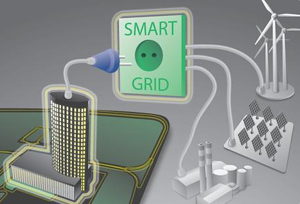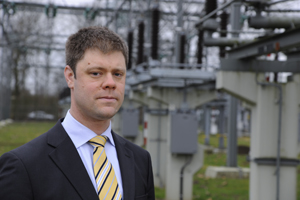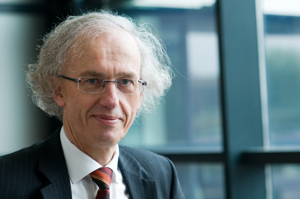'A complete transformation of the system as we know it'
on
The smart grid vision of Distribution System Operator Enexis
'A complete transformation of the system as we know it'
There is widespread agreement among energy experts that a transition to a low-carbon future will not be possible in Europe without the large-scale introduction of "smart grids". But this is no simple matter. According to experts Han Slootweg and Jan Peters of the Dutch network company Enexis, the development of smart grids represents a revolutionary technological change in the electricity market. One moreover that involves a great many stakeholders. But the benefits are significant: 'the introduction of smart grids means that you invest in ICT instead of in expansion of your networks'.
 |
| illustration: Yoga IB |
But publishing admonitions is easy. The hard part is how to make things happen. The IEA notes that many countries have plans, but concrete projects are often lacking. 'We need to see much more aggressive investment in large-scale regional pilots', notes the IEA. It also points out that there is a need for more international coordination and cooperation, in order for countries to learn from each other, reduce costs, and achieve some form of standardisation. But in the end the IEA cannot do much more than urge countries to take action.
As a policymaking body, the European Commission is in a position to take more concrete steps, but in fact its smart grids proposal does not go much beyond urging Member States to "do something". The only concrete action the Commission itself is taking is that it has mandated the European Standardisation Organisation to develop common EU-level technical standards. In addition, the Commission requires Member States to produce an implementation plan for the roll-out of smart meters by September 2012. But there are no requirements for the implementation of smart grids.
Decarbonised
The fact is Brussels cannot make the massive investments that are required nor can it change national regulatory regimes for network companies. But those are precisely the steps that have to be taken to make the smart grids revolution come true. One group of companies that could be key players in this
| 'I see a remarkable culture of innovation among the DSO's' |
The official goals of EDSO for Smart Grids are:
- to enable the transmission and distribution of up to 35% of electricity from dispersed and concentrated renewable sources by 2020 and make electricity production completely decarbonised by 2050
- to further integrate national networks into a truly pan-European, market based network
- to optimise the investments and operational costs involved in upgrading the European electricity networks to respond to the new challenges
These sound like pretty ambitious - and very long-term - objectives, but according to Jan Peters, Director of Asset Management at the Dutch DSO Enexis, and also board member of EDSO for Smart Grids as well as Chairman of DSO Directors Gathering of industry association Eurelecric, this is not so surprising. DSO's, he says, are typically companies with long-range views. 'As publicly owned network companies, we can afford to invest for the longer term. We are not driven by short-term profits, like the supply companies.'
New level
Peters says almost all the DSO's in the EU - whether they are independent or part of a larger group - are more than ready to participate actively in the energy transition. 'I see a remarkable culture of innovation
| 'As publicly owned network companies, we can afford to invest for the longer term' |
Peters says the European DSO's seek international cooperation because they are all faced with the same challenges, especially when it comes to implementing smart grids. 'Our staff is getting older, there is a shortage of technical people. At the same time we need to invest heavily in technological skills. After all, with the advent of smart grids, we will start to use ICT in our networks for the first time. That's a big challenge for us.'
 |
| Han Slootweg: 'The electric car makes demands on the system, but it also offers new possibilities' |
Less variable
Over the last century, says Slootweg, the electricity supply gradually became ever more centralised. The cables got thicker, the voltages got higher, the connections expanded. And all this time the sector (the supply side) simply followed the demand in the market - demand which could not be influenced one way or the other. Now, he says, we are faced with two major changes. 'First of all, decentralised power production will be added to the system. So we will get a complex combination of decentralised and centralised power. At the same time, demand will for the first time become responsive to price changes, whereas supply will become less variable, as a result of the advent of intermittent renewable energies. So we are talking about a complete transformation of the system as we know it.'
And that's not all. The new electricity system will also have to accommodate the expected large scale introduction of the electric car. 'This is a development that should be taken into account right from the start', says Slootweg. 'The electric car makes demands on the system, but it also offers new possibilities, such as storage of electricity in car batteries.'
All these new developments taken together can only be adequately handled, says Slootweg, by 'adding intelligence to the existing system'. What this intelligence has to accomplish is 'enhance flexibility on the demand side and allow for the integration of decentralised generation into the system.' On the basis of these new requirements, Enexis has developed an overall plan for the introduction of smart grids, which the company calls the "mobile smart grid". (The term "mobile" refers to the integration of the electric car into the grid.) As part of this concept, Enexis is participating in a joint venture with other DSO's and Dutch transmission system operator Tennet, with the goal of building 10,000 public charging points for electric cars in cities across the Netherlands.
Controversial
Nevertheless, Peters and Slootweg are aware that network operators are only one of the participants that have to get involved if smart grids are to be developed successfully. 'What makes the practical implementation of smart grids so complex', says Peters, 'is that there are so many stakeholders involved: network companies, traditional energy producers, new energy producers, energy suppliers, technology companies, regulators, consumers, public authorities. They all have a role to play and their interests have to be aligned.'
For example, says Peters, producers and suppliers will have to be prepared to start charging variable rates. This means they will have to start getting their customers involved, who in their turn will have to be prepared to change their consumption patterns. And there are a number of controversial issues that still
| 'You can charge all electric cars of all commuters who drive 70 kilometres per day without building one new power station, if you do it during the night' |
For the network companies, whose tariffs are controlled by the regulator, the most important question is that of regulation. 'The existing regulatory framework is aimed at ensuring that network operators do not abuse their natural monopoly', says Slootweg. 'And that they invest only when market parties want them to, against the lowest possible costs. It does not provide incentives for network operators to make long-term investments that are of general public interest. What's more, it's based on historical cost patterns, whereas at this moment a much higher level of investment is called for.'
Blueprints
 |
| Jan Peters: 'If regulators continue to regulate us purely on the basis of financial standards, we might not be able to do what is needed' |
So what if the smart grids won't materialise, or not on time? 'In that case', says Slootweg, 'you will get problems in your balancing regime. It means you will have to make huge additional investments to expand your network capacity to accommodate renewables and decentralised sources.' After all, he notes, 'the introduction of smart grids means that you invest in ICT instead of in expansion of your networks. Don't forget that currently we use only 50% of the capacity of the networks. With smart grids and smart meters, you can use the capacity of the networks much more effectively.'
Slootweg points out that 'you can charge all electric cars of all commuters who drive 70 kilometres per day without building one new power station, if you do it during the night'.
Of course, he adds, 'all this only applies if you take the energy transition seriously. Smart grids are a means, not an end. If you decide to build coal-fired power stations and forget about electric cars and renewables, the existing system will do just fine.'


Discussion (0 comments)